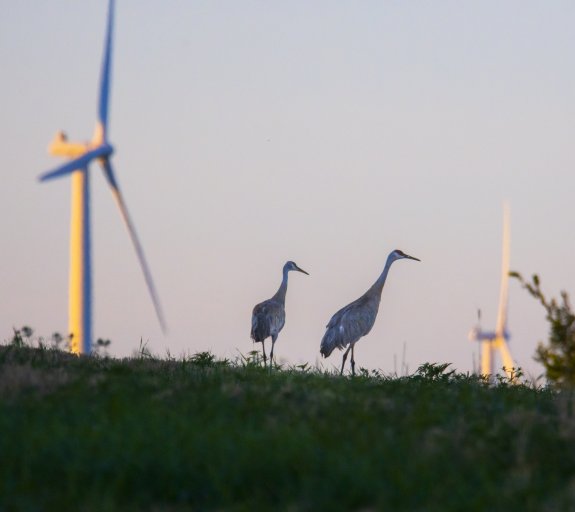
Biodiversity and net zero - does the energy transition have a clean conscience?
The transition to more sustainable methods of electricity production has gained increasing prominence in the fight to maintain the future of our planet, society, and economy. Wind turbines, solar panels and biofuels are providing valuable and renewable sources of energy, as well as providing additional autonomy to countries and regions which have previously relied on established fossil fuel pipelines and trade agreements for their energy security.
Whilst the continued development of these industries is undoubtably a positive step towards meeting critical net zero and climate targets, it’s important to remember that the climate emergency is inextricably linked to the biodiversity crisis. Land and animal preservation is one of the key themes at the forefront of investing in biodiversity. Awareness of the inherent value of natural capital, and its function underpinning all economic activities, is growing1 At the COP 15 Biodiversity conference in 2022, global targets and frameworks were agreed which included a commitment to protect at least 30% of land and water ecosystems by 2030.2Globally, we are increasingly appreciating the importance of safeguarding our planet for future generations, and that this requires investors to more holistically consider the value of natural capital and species abundance. How, then, can we reconcile the need for cleaner, sustainable energy – particularly technologies with relatively intensive land use requirements, such as onshore wind or solar panels - with the need to minimise creating further demands upon our already stretched natural resources? When it comes to analysing methods of sustainable energy production, investors must consider the impacts and demands on biodiversity arising from land use, and therefore the overall net impact potential, of sustainable energy production.
Achieving better outcomes for conservation and embedding this as a fundamental facet of the clean energy transition is a cause championed by The Nature Conservancy, as detailed in its Power of Place Principles.3 It recognises both the issue at hand, in terms of navigating the limitations of occupying finite land mass and the associated need to preserve delicate ecosystems, whilst recognising the requirement for considerable amounts of clean energy capacity growth to achieve net zero targets. Happily, it is not merely a cautionary tale. While these two objectives may at first seem to be at odds with one another, the report is generally optimistic that building these considerations into early-stage planning, and being selective and discerning about the siting of existing clean energy projects - combined with advances in wildlife-friendly technologies - can help benefit conservation and net zero efforts simultaneously. Balancing the need for clean energy production whilst protecting biodiversity is indeed complex, which is why access to leading research resources and capabilities, with the expertise and experience needed to identify the most promising companies, is so crucial for responsible investors.
Regulations and incentives also have a significant role when it comes to ensuring biodiversity is not jeopardised at the expense of clean energy growth, as can be seen from recent developments in the US. The wide scope of the Inflation Reduction Act of 2022 includes a range of measures designed to encourage the transition to sustainable energy for US citizens and corporations alike. The creation of ‘energy communities’, comprising communities of former coal miners and housing brownfield sites, uses significant tax credit incentives to promote the use of previously developed areas to minimise additional land use when developing new clean energy projects.4 Additionally, including additional ‘communities’ with close links to fossil fuel industries further pushes regions which have historically resisted loosening these deep-rooted affiliations to fossil fuel production.
Financial incentives are also a key driver for the US residential solar market. After an already notable 34% rise in solar panel installations during 2021, the 2002 Act, which introduced a 30% solar tax credit to soften the initial financial outlay, is already showing signs of further acceleration as consumers seek ways to reduce the impact of rising utility bills against a backdrop of interrupted supply and geopolitical tensions.5 Whilst a survey conducted by the Pew Research centre showed that 92% of respondents considering (or having already installed) solar panels on their homes in 2022 did so for financial reasons, the second largest reason – to save the environment – was close behind at 81%. This bodes well for the future; while the initial drivers of the clean energy transition at the consumer level are likely economic, the end benefit to the environment – without the need for further land use by leveraging existing properties – is still positive, and could catalyse increased residential solar adoption. This would increase clean energy production in the short-to-medium-term, and further build upon a greater awareness of the need for clean energy amongst younger generations who are set to become the homeowners of the future.6
While the enthusiasm to grow investment in clean energy technologies is laudable and should not be taken for granted, it must be harnessed in a holistic and thoughtful manner so that the long term interests of all stakeholders are accounted for.
As The Nature Conservancy report points out, there is no ‘one size fits all’ solution to such a complex and unique series of challenges. Investors must carry out diligent analysis of all the risks and opportunities to ensure the most impactful use of capital to support both the energy transition and protection and restoration of biodiversity. Only then can we be confident of participating in long-term growth aimed at providing responsible investment outcomes for both clients and the planet.
- https://www.oecd.org/environment/resources/Executive-Summary-ENV-Policy-Paper-no-26-Biodiversity-Natural-Capital-and-the-Economy.pdf
- COP 15, Global Biodiversity Framework; COP15 ends with landmark biodiversity agreement (unep.org)
- Power of Place: Clean Energy Solutions for People and Nature
- Redefining America's ‘Energy Communities’ Can Boost Clean Energy Investments | World Resources Institute (wri.org)
- Home solar panel installations are booming in the US. Why? | World Economic Forum (weforum.org)
- Gen Z, Millennials Stand Out for Climate Change Activism, Social Media Engagement With Issue | Pew Research Center

Equities
Equity investing offers the opportunity to share in the returns generated by companies around the world, whether they are established leaders or dynamic smaller companies.
Find out moreDisclaimer
This document is for informational purposes only and does not constitute investment research or financial analysis relating to transactions in financial instruments as per MIF Directive (2014/65/EU), nor does it constitute on the part of AXA Investment Managers or its affiliated companies an offer to buy or sell any investments, products or services, and should not be considered as solicitation or investment, legal or tax advice, a recommendation for an investment strategy or a personalized recommendation to buy or sell securities.
Due to its simplification, this document is partial and opinions, estimates and forecasts herein are subjective and subject to change without notice. There is no guarantee forecasts made will come to pass. Data, figures, declarations, analysis, predictions and other information in this document is provided based on our state of knowledge at the time of creation of this document. Whilst every care is taken, no representation or warranty (including liability towards third parties), express or implied, is made as to the accuracy, reliability or completeness of the information contained herein. Reliance upon information in this material is at the sole discretion of the recipient. This material does not contain sufficient information to support an investment decision.
Issued in the UK by AXA Investment Managers UK Limited, which is authorised and regulated by the Financial Conduct Authority in the UK. Registered in England and Wales, No: 01431068. Registered Office: 22 Bishopsgate, London, EC2N 4BQ.
In other jurisdictions, this document is issued by AXA Investment Managers SA’s affiliates in those countries.
© 2023 AXA Investment Managers. All rights reserved
Risk warning
The value of investments, and the income from them, can fall as well as rise and investors may not get back the amount originally invested.
AXA IM and BNPP AM are progressively merging and streamlining our legal entities to create a unified structure
AXA Investment Managers joined BNP Paribas Group in July 2025. Following the merger of AXA Investment Managers Paris and BNP PARIBAS ASSET MANAGEMENT Europe and their respective holding companies on December 31, 2025, the combined company now operates under the BNP PARIBAS ASSET MANAGEMENT Europe name.